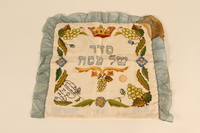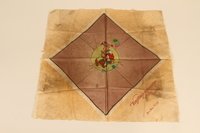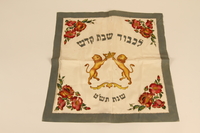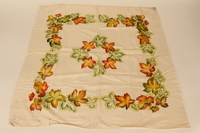Overview
- Brief Narrative
- Handmade notebook from the collection relating to to the experiences of Poldek (Leopold) Schein in prewar Poland, prior to his escape from Krakow to Soviet occupied Poland and his subsequent imprisonment in a Siberian labor camp and resettlement in Uzbekistan during the Holocaust, and to his life in Bergen-Belsen displaced persons camp in Germany and in the United States after the end of World War II.
- Credit Line
- United States Holocaust Memorial Museum Collection, Gift of Leopold Schein
Physical Details
- Classification
-
Office Equipment and Supplies
- Category
-
Stationery
- Object Type
-
Notebooks (lcsh)
- Physical Description
- Handmade notebook with pressed flower cover.
- Dimensions
- overall: Height: 4.500 inches (11.43 cm) | Width: 3.250 inches (8.255 cm)
- Materials
- overall : paper, plastic, string
Rights & Restrictions
- Conditions on Access
- No restrictions on access
- Conditions on Use
- Restrictions on use
Keywords & Subjects
- Topical Term
- World War, 1939-1945--Prisoners and prisons, Soviet.
Administrative Notes
- Legal Status
- Permanent Collection
- Provenance
- The notebook was donated to the United States Holocaust Memorial Museum in 2012 by Leopold Schein.
- Record last modified:
- 2022-07-28 18:26:54
- This page:
- https://collections.ushmm.org/search/catalog/irn631800
Download & Licensing
In-Person Research
- By Appointment
- Request 21 Days in Advance of Visit
- Plan a Research Visit
- Request to See This Object
Contact Us
Also in Leopold Schein collection
The collection consists of handpainted textiles, handmade notebook, correspondence, documents, photographs, and photograph albums relating to the experiences of Poldek (Leopold) Schein in prewar Poland, prior to his escape from Krakow to Soviet occupied Poland and his subsequent imprisonment in a Siberian labor camp and resettlement in Uzbekistan during the Holocaust, and to his life in Bergen-Belsen displaced persons camp in Germany and in the United States after the end of World War II.
Date: 1921-approximately 1956

Silk matzah holder with a handpainted fruit and floral design for Passover created by a Jewish Polish refugee in Bergen-Belsen DP camp
Object
Silk matzoh holder with pockets and a hand painted harvest design painted by Poldek (Leopold) Schein in 1948, when he was living in Bergen-Belsen displaced persons camp. It is made from parachute silk as a gift for his uncle Jacob who sponsored his immigration. It has an inscription to "Our beloved aunt and uncle Pepi and Leib Schein Belzen 1948." The paints were sent to him by hin uncle from the United States. Poland was invaded by Nazi Germany on September 1, 1939. Nineteen year old Poldek lived in Krakow with his parents Abraham and Mania, three brothers, Joseph, Herman, and Jacob, and two sisters Esther and Helena. Poldek, his father, and his two older brothers left to enlist in the Polish Army. They traveled to Lwow, but soon after they arrived, the city surrendered to the Soviet Army. In 1940, Polish refugees were told they must become Soviet citizens. The Scheins refused and were sent to Kalchug, a forestry labor camp in Siberia. Abraham became ill and died that summer. In 1941, the three brothers, and other Polish refugees, were released from the camp and permitted to settle elsewhere in the Soviet Union. They went to Uzbekistan where they lived until the end of the war. Germany surrendered in May and that summer they left for Poland. They found almost no family members in Krakow. They decided to leave for Germany, and settled in the DP camp in Bergen-Belsen because they were told that it had a large Jewish community. Leopold worked painting houses, and eventually became head of graphics for the Jewish community. He married Pepi Levi, a survivor from Łódź, in December 1947. Joseph and Herman emigrated to Canada. A paternal uncle, Jacob Schein, in New York helped Poldek and Pepi get US immigration visas and they arrived in 1949. It was presumed that Leopold's mother, sisters, and youngest brother had been deported to Auschwitz and killed. In 1990, Leopold traveled to Poland and discovered that they had been shot by a guard on the train platform while waiting to be deported.

Silk scarf with a handpainted clown and an inscription created by a Jewish Polish refugee in Bergen-Belsen DP camp
Object
Silk scarf with a design painted by Poldek (Leopold) Schein for his future wife Pepi on November 14, 1946, when he was living in Bergen-Belsen displaced persons camp. The scarf features a jack-in-the-box jester with a book and best wishes from Poldek and his best friend Romek. On December 25, 1947, Pepi and Poldek had a double wedding with Romek and Pepi's adopted sister Madelaine. Romek died of a hernia in the DP camp in 1949. Poland was invaded by Nazi Germany on September 1, 1939. Nineteen year old Poldek lived in Krakow with his parents Abraham and Mania, three brothers, Joseph, Herman, and Jacob, and two sisters Esther and Helena. Poldek, his father and his two older brothers left to enlist in the Polish Army. They traveled to Lwow, but soon after they arrived, the city surrendered to the Soviet Army. In 1940, Polish refugees were told they must become Soviet citizens. The Scheins refused and were sent to Kalchug, a forestry labor camp in Siberia. Abraham became ill and died that summer. In 1941, the three brothers, and other Polish refugees, were released from the camp and permitted to settle elsewhere in the Soviet Union. They went to Uzbekistan where they lived until the end of the war. Germany surrendered in May and that summer they left for Poland. They found almost no family members in Krakow. They decided to leave for Germany, and settled in the DP camp in Bergen-Belsen because they were told that it had a large Jewish community. Poldek worked painting houses, and eventually became head of graphics for the Jewish community. He married Pepi Levi, a survivor from Łódź, in December 1947. Joseph and Herman emigrated to Canada. A paternal uncle, Jacob Schein, in New York helped Poldek and Pepi get US immigration visas and they arrived in 1949. It was presumed that Leopold's mother, sisters, and youngest brother had been deported to Auschwitz and killed. In 1990, Leopold traveled to Poland and discovered that they had been shot by a guard on the train platform while waiting to be deported.

Challah cover with a handpainted crest of lions with a crown with a Star of David created by a Jewish Polish refugee in Bergen-Belsen DP camp
Object
Silk hallah cover with a design painted by Poldek (Leopold) Schein in 1948 when he was living in Bergen-Belsen displaced persons camp. The cover is made from parachute silk and has an image of two golden lions holding a gold crown topped with a Star of David, with red flower clusters in each corner. The paints were sent to him by his uncle in the United States. Poland was invaded by Nazi Germany on September 1, 1939. Nineteen year old Poldek lived in Krakow with his parents Abraham and Mania, three brothers, Joseph, Herman, and Jacob, and two sisters Esther and Helena. Leopold, his father and his two older brothers left to enlist in the Polish Army. They traveled to Lwow, but soon after they arrived, the city surrendered to the Soviet Army. In 1940, Polish refugees were told they must become Soviet citizens. The Scheins refused and were sent to Kalchug, a forestry labor camp in Siberia. Abraham became ill and died that summer. In 1941, the three brothers, and other Polish refugees, were released from the camp and permitted to settle elsewhere in the Soviet Union. They went to Uzbekistan where they lived until the end of the war. Germany surrendered in May and that summer they left for Poland. They found almost no family members in Krakow. They decided to leave for Germany, and settled in the DP camp in Bergen-Belsen because they were told that it had a large Jewish community. Poldek worked painting houses, and eventually became head of graphics for the Jewish community. He married Pepi Levi, a survivor from Łódź, in December 1947. Joseph and Herman emigrated to Canada. A paternal uncle, Jacob Schein, in New York helped Poldek and Pepi get US immigration visas and they arrived in 1949. It was presumed that Leopold's mother, sisters, and youngest brother had been deported to Auschwitz and killed. In 1990, Leopold traveled to Poland and discovered that they had been shot by a guard on the train platform while waiting to be deported.

Tablecloth with a handpainted maple leaf design created by a Jewish Polish refugee in Bergen-Belsen DP camp
Object
White tablecloth made from parachute silk with a maple leaf border painted by Poldek (Leopold) Schein around 1948 when he was living in Bergen-Belsen displaced persons camp. The paints were sent to him by his uncle in the United States. Poland was invaded by Nazi Germany on September 1, 1939. Nineteen year old Poldek lived in Krakow with his parents Abraham and Mania, three brothers, Joseph, Herman, and Jacob, and two sisters Esther and Helena. Poldek, his father and his two older brothers left to enlist in the Polish Army. They traveled to Lwow, but soon after they arrived, the city surrendered to the Soviet Army. In 1940, Polish refugees were told they must become Soviet citizens. The Scheins refused and were sent to Kalchug, a forestry labor camp in Siberia. Abraham became ill and died that summer. In 1941, the three brothers, and other Polish refugees, were released from the camp and permitted to settle elsewhere in the Soviet Union. They went to Uzbekistan where they lived until the end of the war. Germany surrendered in May and that summer they left for Poland. They found almost no family members in Krakow. They decided to leave for Germany, and settled in the DP camp in Bergen-Belsen because they were told that it had a large Jewish community. Poldek worked painting houses, and eventually became head of graphics for the Jewish community. He married Pepi Levi, a survivor from Łódź, in December 1947. Joseph and Herman emigrated to Canada. A paternal uncle, Jacob Schein, in New York helped Poldek and Pepi get US immigration visas and they arrived in 1949. It was presumed that Leopold's mother, sisters, and youngest brother had been deported to Auschwitz and killed. In 1990, Leopold traveled to Poland and discovered that they had been shot by a guard on the train platform while waiting to be deported.

Ration coupons
Object
Ration coupons from the collection relating to to the experiences of Poldek (Leopold) Schein in prewar Poland, prior to his escape from Krakow to Soviet occupied Poland and his subsequent imprisonment in a Siberian labor camp and resettlement in Uzbekistan during the Holocaust, and to his life in Bergen-Belsen displaced persons camp in Germany and in the United States after the end of World War II.
Leopold Schein papers
Document
Photographs, albums, and correspondence documenting Leopold Schein's experiences during the Holocaust. Collection includes album of family photographs, a wedding album from Harzburg/Bergen-Belsen displaced persons camp, family autograph book commemorating the 1926 visit of American uncle Jack Schein to Krakow, documents for Leopold Schein, a "Familien Stammbuch" issued to Leopold Schein in 1949 in Celle, documents from the Bergen Belsen displaced persons camp and assorted family photographs.



